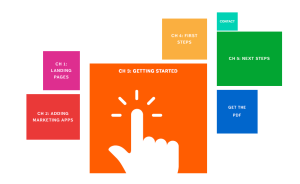In the beginning, there was the word.
Literally, just text on a web page.
Today, however, content marketing is evolving into something not unlike freemium games, at least according to Scott Brinker.
Brinker is the éminence grise behind ChiefMartec.com, the popular marketing-technology blog. He’s the apparently extremely patient and dedicated person who assembled a massive list of 947 companies in 43 categories within “martec,” and he’s also the chief technical officer of Ion Interactive, which has recently bet its future on marketing apps.
So he’s not exactly a disinterested observer.
But I wanted to hear from Brinker what he believes the first three waves of content marketing to be — and what he characterizes as this next fourth wave.
VentureBeat: You’ve talked about four waves of content marketing. What were the first three waves?
Brinker: The first wave was simply publishing content on the web, but mostly [it was] just text.
The second wave progressed from text to rich content: videos, infographics, slide decks, beautifully designed e-books, etc.
And the third wave is the application of personalization technology to content marketing.
VentureBeat: What characterized the first and second waves? What made them work?
Brinker: The first wave was revolutionary for two key reasons:
- Marginal costs of distribution effectively dropped to zero, so companies could publish as much as they could produce.
- Search engines made this content accessible to prospects and customers on-demand, in a self-service manner.
Do you use a marketing automation like Hubspot, Marketo, Eloqua, Act-On, Pardot, or others?
Be the analyst … and review it for profit and kudos.
This first wave birthed the disciplines of search engine optimization (SEO), inbound marketing, and content marketing as we know them today. Companies were competing on delivering more content.
The second wave of more visual content marketing resonated more powerfully with people — and with the rise of social media as a major channel for distribution, producing content that people wanted to share became incredibly important. Companies were now competing on delivering not just more content but better content.
But as a consequence, the volume of content in search and social channels has grown exponentially. The biggest challenge in content marketing today is breaking through that noise.
VentureBeat: Was the third wave, personalization, a game-changer? Or did it promise more than it could deliver?
Brinker: Because there’s now so much content out there — companies are producing far more content than prospects or customers can reasonably find and consume — applying personalization technology to try to filter that deluge into a drinkable glass of water makes a lot of sense.
However, personalization is not a silver bullet.
It’s not realistic to expect that within a few clicks of the beginning of a buyer’s journey that we will be able to perfectly predict the right content to show them. We need enough data on someone to move from superficial correlations to meaningful deductions. Overly hasty assumptions can actually push prospects into the wrong content and derail their momentum with you.
Personalization definitely has a role in content marketing. But it’s most effective for serendipitous content — such as Amazon recommendations, where the cost of a wrong guess is negligible — or for tailoring interactions deeper in the buyer’s journey once we know them better.
VentureBeat: What’s the fourth wave, in your opinion?
Brinker: I believe the fourth wave is making content more interactive, on a mass scale.
The fourth wave will be a proliferation of responsive web “marketing apps” — wizards, configurators, calculators, assessment tools, interactive white papers, participatory ebooks, games, quizzes, guided tours, contests, diagnostics, workbooks, utilities, and a wide range of entertaining and educational experiences.
VentureBeat: What makes this better?
Brinker: While we marketers can lament about breaking through the noise in content marketing, that cacophony of content is also a burden for our audience, too. There are only so many white papers you can read and so many webinars you can sit through each week before your eyes glaze over.
Marketing apps open up more creative ways for people to engage with useful or entertaining content. They take inspiration from dialogues that great salespeople have with prospects and participatory learning activities that great teachers use to captivate students. When done well, these experiences can give prospects helpful insights faster and more enjoyably than just passively reading an ebook.
And for marketers, think of the rich behavioral data that people’s interactions with these marketing apps can reveal.
It moves us beyond take-it-or-leave content. Most content marketing today has either been completely free and open, such as websites and blogs, or completely gated behind a lead generation form. With free content, there’s no direct opportunity to convert people into leads. With gated content, however, most visitors won’t convert — people are skeptical of what’s behind the submit button — so they miss out on any real impression of what you have to offer.
With responsive web marketing apps, we can mix these two models. We can engage someone with the content right away, with no barrier, and then offer them a gated reward or bonus once they’ve started to engage with the app and see its value.
VentureBeat: This almost sounds like it could verge into similar territory as freemium mobile apps, where you can access some features for free, but others are paid?
Brinker: Yes, that’s a terrific analogy for this new kind of content marketing.
Like drawing someone into a free native mobile app to persuade them to unlock paid features, we’re drawing prospects into a free piece of interactive content to persuade them to “convert” with lead information for premium content features within a responsive web marketing app.
For example, you might have a quiz-like marketing app that lets prospects test their knowledge on a particular topic. Anyone can take the quiz for free, and as they go through it, you’re teaching them valuable content at each step. You can show them which answers they get right or wrong. But then as a bonus at the end, you can offer them — in exchange for their lead information — a follow-up email that compares their scores with their peers and provides deeper explanations of the right answers.
Done well, these freemium marketing apps can achieve higher conversion rates than simply gating an entire content asset, like a white paper or ebook, behind a lead generation form.
VentureBeat: That’s been done for a while, right? Freemium has been around as long as people were selling services online, like e-trading sites that permited you to set up a dummy portfolio, no?
Brinker: Absolutely, interactive applications have been a big part of the web. But they’ve mostly been bespoke software projects, custom built by IT departments, product engineering teams, or digital agencies. They were expensive and time consuming to build and maintain. While that investment made sense if the application was your core product, it often wasn’t justifiable to have that kind of spend on lightweight marketing apps.
But now, a number of SaaS products are blossoming for marketers that completely change the economics of producing responsive web marketing apps. They let non-technical marketers build and deploy these lightweight apps in campaigns and websites on their own, for a fraction of the cost of custom development.
There’s tremendous innovation happening in this space today. My company, Ion interactive, is one provider of a marketing apps platform. But other interesting companies in this field include SnapApp, Wishpond, Woobox, Offerpop, Pugpig, Ceros, LookBookHQ, and more.
VentureBeat: It’s almost “experience marketing,” isn’t it?
Brinker: There are strong parallels between experiential marketing in the physical world and marketing apps in the digital world. Experiential marketing in the real world engages people with a brand through free samples, pop-up stores, real-life games, demonstrations — something interactive, rather than passive TV, radio, print, and outdoor advertising. Such experiences can be far more memorable than any ad.
That’s exactly the opportunity marketers can pursue with marketing apps on the web — interactive rather than passive brand touchpoints. Digital experiential marketing, if you will.
VentureBeat: Is this limited to certain kinds of companies, and certain kinds of products?
Brinker: Like the previous three waves of content marketing, I believe this fourth wave of interactive content is universal at its core.
Of course, different kinds of marketing apps, with different kinds of content embedded in them, will resonate better with different kinds of audiences. A fun B2C brand might have better success with a game-like app, while a more serious B2B brand would do better with something like an assessment tool or an ROI calculator.
VentureBeat: What else can you tell me about marketing apps?
Brinker: I would emphasize that these are primarily responsive web apps, rather than native mobile apps on iOS and Android. Native mobile apps are terrific, but they tend to be different in nature.
Responsive web apps are typically more lightweight and disposable. You can have dozens of them deployed in different kinds of marketing campaigns or embedded on different pages in your website. You don’t have to have approval to publish them in an app store. Most importantly, your audience doesn’t have to explicitly install anything — they can just start using your app in the flow of a web experience, on whatever device they’re connected with.
It’s not an either/or choice for marketers. Both native mobile apps and responsive web apps have their place. In fact, you can use responsive web marketing apps to help drive people to install your native mobile app.
VentureBeat's mission is to be a digital town square for technical decision-makers to gain knowledge about transformative enterprise technology and transact. Learn More




